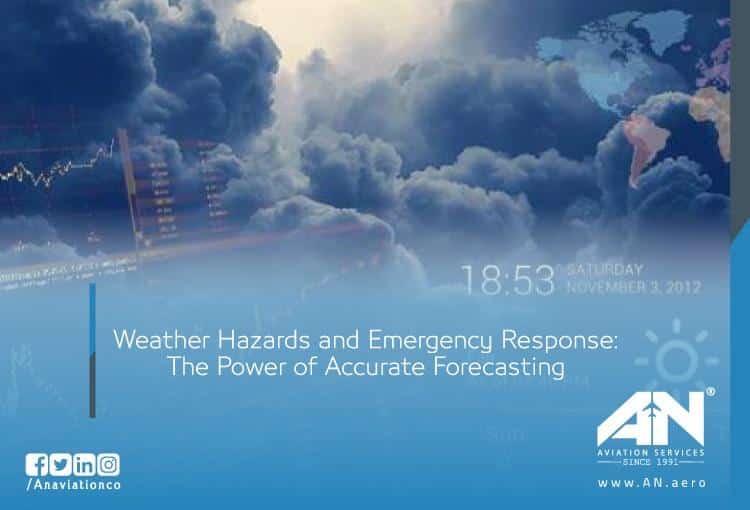
Weather can be as unpredictable as it is powerful, posing significant challenges to aviation, transportation, infrastructure, and public safety. Whether it’s high winds disrupting air traffic, winter weather delaying operations, or flash floods wreaking havoc on communities, accurate and timely weather forecasts are critical. These forecasts don’t just guide day-to-day activities—they save lives and ensure the continuity of essential services during extreme weather events.
In this blog post, we’ll explore the role of accurate weather forecasting in identifying and mitigating weather hazards, its connection to emergency response systems, and why it’s an essential tool in safeguarding both people and infrastructure.
Understanding Weather Hazards
Weather hazards refer to severe and often dangerous weather conditions that can threaten lives, damage property, and disrupt operations. From high winds and lightning to flash floods and snowstorms, such conditions demand vigilant monitoring and robust response strategies. Here are some common types of weather hazards and their impact:
- High Winds: Strong wind speeds can disrupt flights, topple power lines, and cause accidents on highways. In aviation, high winds can lead to turbulence, difficulty in landing, or even flight diversions.
- Winter Weather: Heavy snow, freezing rain, and ice accumulation can severely affect transportation systems. Airports may face delays or closures due to icy runways and limited visibility, while roads become treacherous for drivers.
- Flash Floods: Flash flooding is one of the most dangerous weather events, often occurring with little warning. These floods can damage homes, submerge roads, and trap people in hazardous conditions.
- Lightning and Hail: Lightning strikes not only endanger individuals working outdoors but can also damage electrical systems and equipment. Hail, meanwhile, can cause significant damage to vehicles, crops, and buildings.
- Extreme Heat or Cold: Prolonged periods of extreme temperatures can affect infrastructure, including roads, bridges, and even aircraft performance. These conditions can also endanger human lives, especially vulnerable populations like children and the elderly.
Each of these hazards carries unique risks, but the common factor remains the same: accurate forecasting is key to preparedness and mitigation.
The Role of Accurate Weather Forecasts
Reliable weather forecasts provide the foundation for effective planning and emergency response. Using advanced technologies and models, meteorologists can identify evolving weather patterns and issue timely warnings. Organizations like the National Oceanic and Atmospheric Administration (NOAA) play a crucial role in this process, offering real-time data and advisories for various industries and communities.
How Accurate Forecasting Makes a Difference?
Early Warnings: With precise forecasting, agencies can issue warnings and advisories well in advance, allowing businesses and individuals to take necessary precautions. For example, knowing about an incoming flash flood can prompt evacuation efforts and save lives.
- Risk Mitigation for Aviation: Airlines rely heavily on weather forecasts to adjust flight routes and schedules, ensuring safety during adverse conditions like high winds or lightning storms. Accurate data enables pilots to navigate efficiently and avoid hazardous zones.
- Support for Emergency Response: Emergency responders, including disaster relief teams, benefit greatly from real-time weather updates. Forecasts allow them to allocate resources effectively and prioritize areas most at risk.
- Planning for Seasonal Hazards: Seasonal weather patterns, such as hurricanes or winter storms, can be tracked using long-term forecasts. This helps municipalities and businesses prepare for these events through strategic planning and infrastructure reinforcement.
Weather Hazards in the Aviation Industry
The aviation sector is particularly sensitive to changing weather conditions, making forecasting a critical component of operational safety. Here’s how weather impacts aviation and the steps taken to counter its risks:
- High Wind Events: High wind speeds and turbulence can make takeoff and landing extremely challenging. To mitigate this, air traffic controllers and pilots rely on real-time updates on wind speed and direction to adjust flight paths or delay operations if necessary.
- Winter Weather Complications: Snow and ice accumulation on runways and aircraft surfaces can lead to delays or cancellations. Ground handling teams use deicing procedures informed by weather forecasts to ensure aircraft readiness.
- Thunderstorms and Lightning: Aircraft equipped with lightning-resistant features are designed to withstand strikes, but pilots still avoid thunderstorm zones to reduce risks. Modern weather prediction models identify these hazardous areas well in advance.
- Fog and Low Visibility: Visibility issues, caused by fog or haze, can delay operations at airports. Instrument landing systems and flight planning strategies, guided by forecast data, help pilots land safely under such conditions.
Emergency Response Strategies for Weather Hazards
Emergency response teams must act quickly during extreme weather conditions to minimize damage and ensure public safety. Accurate forecasting is the backbone of these efforts, allowing responders to focus their resources where they’re needed most.
- Flood Warnings: When a flash flood is imminent, forecast data triggers alerts that help communities evacuate or take protective measures. Public messaging through weather apps and news channels plays a crucial role in raising awareness.
- Snowstorm Preparedness: During winter weather, forecasts enable cities to mobilize snowplows, salt trucks, and emergency vehicles. Airports also use this information to deice aircraft and maintain runway safety.
- Heat or Cold Advisories: Heatwaves and cold spells require special precautions, including hydration stations, warming shelters, and outreach programs for vulnerable populations. Accurate weather forecasting makes these efforts more efficient.
How Technology Elevates Weather Forecasting?
Advances in technology, including artificial intelligence (AI) and machine learning, have transformed how meteorologists predict and track weather hazards. Here’s how innovation is driving improvements in forecasting:
- Numerical Weather Prediction (NWP): This physics-based model simulates weather patterns using large datasets, including atmospheric pressure, wind, and temperature.
- Satellite Observations: Satellites provide a bird’s-eye view of weather systems, offering detailed information on cloud formation, precipitation, and temperature changes.
- AI and Machine Learning: AI algorithms analyze historical data to identify trends and predict future weather patterns with greater accuracy. These technologies also reduce computational costs and improve efficiency.
- Real-Time Updates: Weather apps and systems now deliver up-to-the-minute alerts directly to users, ensuring timely action during emergencies.
Why Accurate Forecasting Matters More Than Ever?
As climate change intensifies, weather hazards are becoming more frequent and severe. Rising global temperatures are contributing to longer heatwaves, stronger hurricanes, and unpredictable storm patterns. Accurate forecasting is no longer just a convenience—it’s a necessity for resilience and safety in the face of these growing challenges.
From safeguarding lives during a flash flood to enabling smooth flight operations during high winds, forecasting empowers us to respond proactively rather than reactively.
Conclusion: Preparedness Through Precision
Weather hazards, while inevitable, don’t have to result in chaos. Through precise and timely weather forecasts, individuals, businesses, and governments can better navigate the challenges posed by extreme conditions. Whether it’s ensuring safety during a snowstorm or responding to a lightning storm with proper planning, accurate forecasting remains an indispensable tool in today’s world.
By combining traditional meteorological practices with cutting-edge technologies, we can continue to improve forecasting accuracy and enhance emergency response systems. In doing so, we can mitigate the impact of weather hazards and build a safer, more resilient future.

